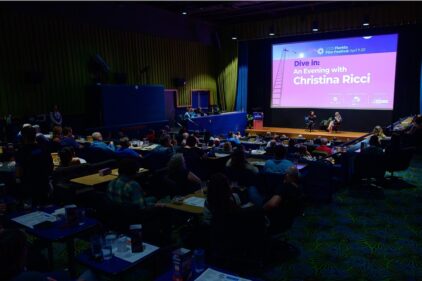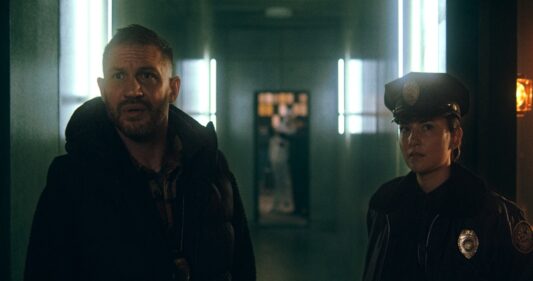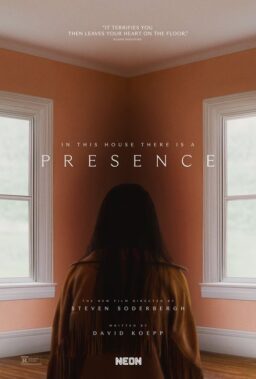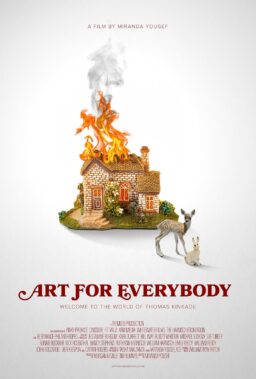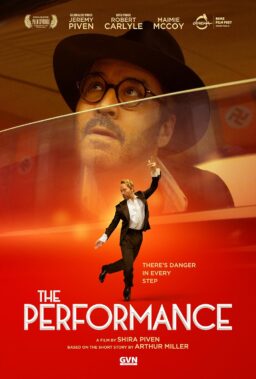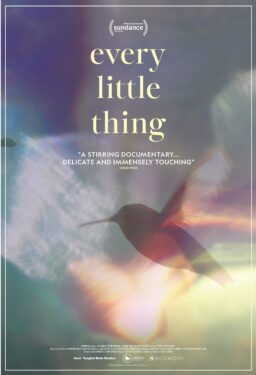With a half-century of game-changing documentaries under its belt, Kartemquin Films will be accompanying its fiftieth anniversary with the latest work from one of its most celebrated filmmakers, Steve James. His 1994 masterpiece, “Hoop Dreams,” was cited by Kartemquin’s co-founder and Artistic Director, Gordon Quinn, as the film that brought the company back to its roots. Since then, James has made several acclaimed films for Kartemquin, including 2002’s “Stevie,” 2011’s “The Interrupters” and 2014’s “Life Itself.” His new feature, “Abacus: Small Enough to Jail,” tells the riveting and criminally underreported story of Abacus Federal Savings, a family-owned bank in Chinatown, New York. James’ film details how Abacus became the only U.S. bank to face criminal charges in the aftermath of the 2008 financial crisis. It also provides an endearing portrait of the Sungs, the family of Chinese immigrants who own the bank, as they engage in a courageous five-year-long legal battle.
On the eve of the film’s Toronto premiere, James spoke with RogerEbert.com about his cherished collaborators, his own take on the Sungs’ case and Kartemquin’s incredible legacy.
What are your thoughts on how the economic crisis has been tackled in other films, such as Charles Ferguson’s 2010 documentary, “Inside Job”?
“Inside Job” is a great example, and there have recently been a rash of films in the narrative world like “The Big Short” that have tackled the topic as well. I enjoyed those films because they did something that I think was vitally important, which was to not let what happened in 2008 slide so easily into the past. They took a full reckoning of the damage that was done by these huge banks and investment firms, not just to the economy but to everyday people. We saw how the crisis directly affected people, resulting in them losing their homes and apartments. Those are welcome and important stories to tell.

What makes your film so essential is that it tells a story few people know about.
This was a story that unfolded outside of the Chinese American media in New York City. It got virtually no coverage anywhere, including The New York Times or any of the other dailies in New York. I have lots of New York friends who are well-read individuals who have never heard of this story, and it was actually our producer, Mark Mitten, who brought the story to my attention. He was an executive producer on “Life Itself,” and I’ve known him for a number of years. Mark knows Vera Sung, and she had shared with him the ordeal that her family was going through. He reached out to me at one point and said, “I think there is a really interesting story here.” Then he drew my attention to Matt Taibbi’s book, The Divide: American Injustice in the Age of the Wealth Gap, and the first chapter is about the Abacus bank. It was written after the indictment but before the case came to trial. The chapter detailed the author’s feelings regarding how this community bank was indicted, and after reading it, I talked to Mark and we decided to go film for a few days to see whether the story seemed like a good one for me to tell. After spending a few days with the Sungs and doing some filming, I realized we had to make this film.
In all of your films, you give the audience a vivid sense of where your subjects come from. What was it like exploring the community of Chinatown?
Chinatown is notoriously closed to outsiders, so I think that if we had ventured there to try and film completely on our own, we wouldn’t have gotten very far. The key in all of the films I’ve done—in terms of gaining access to communities that are either difficult or very different from who I am—is always the subjects, the people that you’re following. They provide the passport, if you will, to these communities. That was true of “The Interrupters,” and it was certainly true of this film. By virtue of the Sung’s place in that community, and particularly the revered stature of Thomas Sung, the founder of the bank, we were allowed to give audiences a view of Chinatown that isn’t seen very often.
I love how you weaved in footage of Frank Capra’s 1946 classic, “It’s a Wonderful Life.”
I wish I could say that it was my idea to put it in the movie, or that it was my idea to even think of “It’s a Wonderful Life” as a kind of metaphor or connection, but really, that came from the people around the Sungs. People would tell us that Thomas reminded them of George Bailey, the hero of “It’s a Wonderful Life,” and then when we talked with the Sungs, we found out that Mrs. Sung watches the film at least once a year and loves it. You get that sense of how much she loves it in the beginning of our film, so it seemed natural for us to include the footage. I thought it would be interesting to try and begin the film with using “It’s a Wonderful Life” as a way in to who the Sungs are and their philosophy of what a savings and loan bank is all about. There were several places in the film where we could’ve come back to “It’s a Wonderful Life,” and in fact, we did in earlier cuts. Then we narrowed it down to just two places because we felt like those were the most relevant and poignant.
How did you go about presenting a balanced view of the story while maintaining your own perspective?
It was tricky in this case because this is a film with a point of view. Clearly, we are with the Sungs in this story. It started that way, and we certainly made overtures to the prosecution side to see if we could get them more involved in the film, but it was very difficult to do. In fact, it was only through the incredible persistence of co-producer Nick Verbitsky that we were able to get through to Polly Greenberg and Cyrus Vance Jr. to participate in the film. They don’t typically do this sort of thing, but Nick didn’t give up, and they finally agreed to do it. We always wanted to hear from the other side and give them the forum and an opportunity to address the substantive issues of the case and their case against the Sungs. Nick took the lead on this, and found the jurors in the case after the fact, because we couldn’t do anything during the trial.
We found a couple of jurors, one who, as it turns out, was on the side of guilt during the deliberation and the other who wasn’t. We purposely did that because this is a case that went into deliberation for ten days. Clearly, the jurors had some struggles around how they wanted to rule. They didn’t come back in two hours with a verdict. It’s incumbent on the film to help you understand both the substance of the trial, and where people were at as they were watching this trial unfold. The film is not a news report, and it does have a point of view. I really endeavor to not make my films didactic. I want to take account of the complexity and the other viewpoints that are there. I feel like that’s essential to do, and it doesn’t happen often enough in the documentary world.

I love how your cinematographer, John Bergmann, and your editors, John Farbrother and David E. Simpson, capture the family dynamics of the Sungs, such as when the youngest daughter struggles to get a word in edgewise.
That was a lovely moment in how it was shot. There’s a temptation in those moments for the DP to swing off and show other people talking, but he just stayed rooted on her, which really makes that scene. I have a long history working with David. He was my co-editor on “Life Itself,” and I first worked with him on “The New Americans” ten years ago. We’ve had a long history of working together and he’s just a fabulous editor. I’ve worked with John more recently on some shorter stuff that I’ve been doing, and he came in to work on “Abacus” in part because I pushed David to start working on my upcoming high school miniseries. When I brought John in, he picked it up in stride and did a terrific job seeing it through to the end.
Another of your “Life Itself” collaborators, Joshua Abrams, composed the film’s score.
Josh is an incredibly talented composer and his tastes run the gamut. The first film he ever scored was “The Interrupters,” and since then, he has done several Kartemquin films, including “Almost There,” “The Trials of Muhammad Ali,” “Life Itself” and now this film. If you listen to the music for all of those, you will hear quite a range. He’s brilliant in how he looks at each film on its own terms and tries to find the right instruments and musical language for it. His music for “Abacus” has Chinese influences, but they are subtle.
Watching “Abacus,” I was reminded of Ezra Edelman’s recent miniseries “O.J.: Made in America.” Just as the defense in the O.J. case claimed to be bringing long-overdue justice to the African-American community, the prosecution in the Abacus case claimed to be bringing long-overdue justice to those hurt by the financial crisis.
I confess I haven’t thought about this in relation to O.J. because I think most African-Americans would say, “Yes, O.J. was guilty, but the case was about a bigger issue.” One of the things that was confounding to me about this case is that the Sungs really are the mirror opposite of the 2008 crisis. They discovered fraud themselves and dutifully reported it to the bank regulators. Then, on their own, they initiated their own internal investigation that resulted in the firing of two other loan officers and a couple of others voluntarily leaving. They cleaned house themselves and did all the right things in terms of reporting it, and yet, that obviously wasn’t enough. They were brought on trial for what amounts to some pretty low-level and petty fraud, and ended up getting put through this five-year ordeal. The Sungs never disputed that fraud happened at their bank. What they disputed was that they had willfully and purposefully encouraged the fraud that happened and that there were any victims to that fraud. The state tried to make it seem as if what had gone on here was akin to 2008 and in every respect, I don’t think it was.
Looking back on the legacy of Kartemquin Films, how are the company’s current films reflective of its classics from the ’60s and ’70s?
Kartemquin has a tremendous legacy. I was in New York for a retrospective this past weekend where they showed some of my work, as well as some of the company’s shorter, earlier work, including “Winnie Wright, Age 11” and “Now We Live on Clifton.” It was interesting to sit and watch those films from many years ago, and I definitely sensed a connection, though the films themselves are even different from each other. But they are all very up-close portraits of everyday individuals and their neighborhood. In other words, there’s no plot unfolding in those stories. They’re not pure observation as in there’s no artistry at all because there is, but they are more observations of the lives of people and that’s good enough. If people are in particularly interesting situations, that is rationale enough for their stories to be told. A lot of the films that are being made at Kartemquin now have greater ambition in terms of story, production, themes and what they’re ultimately about. But at its foundation, Kartemquin still aims to take a clear-eyed look at the world around us and tries to understand it in all its complexity. Kartemquin films are activists in spirit, but they are not activist documentaries in that they are just trying to push an agenda. They really do try to take full account of the complex reality of contemporary life, while doing it with a point of view.
“Abacus: Small Enough to Jail” will make its world premiere Sunday, September 11th, at the Toronto International Film Festival. For more information, visit the official TIFF site.


